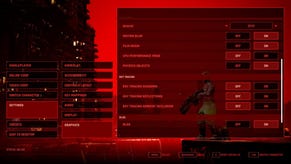The Ascent: an Xbox Series showcase - but how well does it run on Xbox One?
Performance and loading are dramatically improved on the new consoles.
Revealed last year during one of the first Xbox Series console showcases, The Ascent is a stunning testament to the power of Unreal Engine in the hands of smaller studios - and a genuine showcase for what the new wave of consoles can offer. And yet, at the same time, it's also a cross-generation title - and one that works to varying degrees of success of older Xbox One hardware. It might sound strange to put it like this, but The Ascent is mostly decent on the last-gen consoles while at the same time demonstrating in spectacular style just how much of a leap the latest waves of games machines truly are.
The Ascent is a game built primarily by a team of 12 people along with assistance from support studios, but despite the small team, the quality of the experience is impressive, the futuristic cityscapes crammed with detail, backed up by an expert deployment of Unreal Engine 4's post-process pipeline. The game's gorgeous bokeh depth of field and physically-based materials work beautifully with the gorgeous lighting - and there's a pleasing surfeit of particle effects to catch the eye. The game world is made up of numerous extremely large maps populated with a range of NPCs and enemies alike.
The size and scope are remarkably impressive - yes, there are loading screens but they're few and far between. This world is presented primarily from an isometric angle with some occasional camera flourishes in specific sequences. As a result, it almost feels like a living diorama - it harkens back to the old days of pre-rendered isometric PC games, but everything is rendered completely in real-time.
Another element that helps the game feel satisfying lies in its pyrotechnics and attention to detail. You fight your way through a wide range of environments during your time with the game and many of these areas exhibit real damage modelling, adding to the sense of mayhem and destruction in the core shooting. Attention to detail is also impressive - right down to the way the rippling water interacts with excellent ragdoll work on downed foes. Really, though, it's the sheer volume of geometric detail that impresses the most. The art team has crafted so many objects and scene meshes - and the way in which everything is assembled expertly sells the busy, dystopian metropolis look the studio is aiming for.
The Ascent is a gorgeous game but what surprised me even more is that this small team has managed to release it across so many platforms. Xbox One, Xbox One X, both Series consoles and even the PC receive a version of The Ascent and the differences are fascinating. I should start by noting that, visually speaking, it looks great in all cases - the core presentation does shine through no matter where you play but there are serious advantages for the newer machines that we'll get to shortly.
For those curious about the basic image quality metrics, Unreal's temporal image treatment is applied to each version with variable starting resolutions. Xbox Series X rests firmly at the top of the console pile - it targets a maximum of native 4K and uses dynamic resolution scaling to keep the frame-rate up. It's highly dynamic but manages to look crisp and clean. Image quality is superb. Really, though, all versions use dynamic resolution scaling with variable ceilings. Xbox One X tops out at 4K like Series X, Series S tops out at 1440p and Xbox One tops out at 900p. All versions can and do vary pixel counts based on GPU load.
On PC, there are many more options available for users to adjust - in the pre-release build, however, it's clear that there's still work to be done. By default, the DirectX 11 mode runs very well and looks great with Nvidia's DLSS is available producing remarkably clean results. The mouse and keyboard controls are also well implemented and feel even more satisfying to use than a gamepad. There's also a DirectX 12 option available and this mode offers ray tracing features but in the review period, the experience was noticeably choppy - even on extreme hardware, to the point where I swapped back to DX11 per the guidance we received from the developers. I'm hopeful this will be addressed in time as I'd love to see The Ascent pushing UE4's higher-end features.
In the video, I talk more about how the graphical feature set scales across the available platforms, but really it's loading times and performance that truly separate the generations. When it was first shown, the original trailer didn't exactly run well, so I was pleasantly surprised to see that The Ascent delivers 60 frames per second on both Xbox Series X and Series S and while there are some camera glitching issues that look like slowdown (which I hope will be fixed), the game really is very solid indeed on both Series consoles. However, the frame-rate cap drops to 30fps on Xbox One consoles and there are more noticeable lurches in performance when moving through areas, to the point where the game feels somewhat jittery. It's perfectly fine in terms of raw playability, mind you, but it's to the point where I'd easily prefer playing 60fps on the lower resolution Series S up against the 4K-touting 30fps (with drops) on Xbox One X. Loading times? They're OK on Series consoles but not exactly fast - but Xbox One consoles take close to three minutes to load, and so we find a 600 percent improvement comparing One to Series consoles!
It's a stark comparison and I feel this demonstrates just how important CPU and storage speed truly are this generation. Xbox One X technically has a more potent GPU than Series S but these other elements hold it back and you wind up with a lower frame-rate and dramatically slower loading times. Both Series S and X deliver a fantastic experience with this game and here at least, it's only resolution that divides them. Still, by and large, I do feel the developers did a good job with all versions of the game. The loading times are the only serious flaw on the last-gen systems but all users can enjoy a solid experience - and as for the game itself? I had a lot of fun with it and highly recommend checking it out - something that's very easy to do as it's a day one launch game on Xbox Game Pass.










